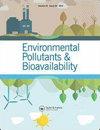评价pH和温度对硫酸盐还原菌的影响及其在搅拌生物反应器中的影响模型
IF 3.2
4区 环境科学与生态学
Q2 BIOCHEMISTRY & MOLECULAR BIOLOGY
Environmental Pollutants and Bioavailability
Pub Date : 2023-09-16
DOI:10.1080/26395940.2023.2257388
引用次数: 0
摘要
地壳中丰富的硫酸盐(SO4)在很大程度上导致了工业废水污染,降低了pH值,从而促进了金属的溶解,形成了酸性排水。生物硫酸盐还原作为一种修复过程会受到pH、温度和高硫化物浓度等因素的影响。本研究以矿井废水中富集的硫酸盐还原菌群为研究对象,在半自动化生物反应器中考察了这些因素对微生物硫酸盐还原能力的影响。低pH(3.5)和温度(10°C)促进了硫还原物种对联盟的毒性,而中温温度(25°C)和接近中性的pH(6.2)则诱导了最佳的SO4还原,达到最高95%的SO4还原。然后将获得的SO4还原动力学数据应用于构建一个独特的非竞争性抑制方程,该方程模拟了不同pH和温度条件下SO4还原过程中的生物地球化学事件,并预测了生物修复系统的效果。本文章由计算机程序翻译,如有差异,请以英文原文为准。
Evaluating the effects of pH and temperature on sulphate-reducing bacteria and modelling of their effects in stirred bioreactors
Sulphate (SO4) abundance in the earth’s crust contributes largely to industrial wastewater contamination lowering the pH, which exuberates the dissolution of metals forming acidic drainages. Biological sulphate reduction as a remediation process can be affected by factors such as pH, temperature and high sulphide concentrations. In this study, sulphate-reducing bacterial community enriched from mine wastewaters was applied in semi-automated bioreactors to assess the effects of these factors on microbial sulphate reduction capacities. Low pH (3.5) and temperature (10°C) were observed to promote the toxicity of sulphur-reduced species on the consortium while mesophilic temperature (25°C) and near neutral pH (6.2) were observed to induce optimum SO4 reduction attaining a maximum of 95% SO4 reduction. Obtained SO4 reduction dynamics data was then applied in formulating a unique non-competitive inhibition equation that models biogeochemical events during SO4 reduction under varied pH and temperature conditions and predicts the efficacy of a bioremediation system.
求助全文
通过发布文献求助,成功后即可免费获取论文全文。
去求助
来源期刊

Environmental Pollutants and Bioavailability
Chemical Engineering-Chemical Health and Safety
CiteScore
4.30
自引率
3.00%
发文量
47
审稿时长
13 weeks
期刊介绍:
Environmental Pollutants & Bioavailability is a peer-reviewed open access forum for insights on the chemical aspects of pollutants in the environment and biota, and their impacts on the uptake of the substances by living organisms.
Topics include the occurrence, distribution, transport, transformation, transfer, fate, and effects of environmental pollutants, as well as their impact on living organisms. Substances of interests include heavy metals, persistent organic pollutants, and emerging contaminants, such as engineered nanomaterials, as well as pharmaceuticals and personal-care products as pollutants.
 求助内容:
求助内容: 应助结果提醒方式:
应助结果提醒方式:


